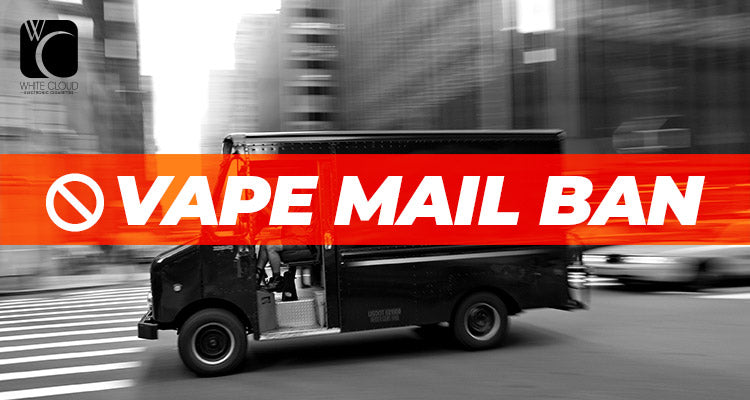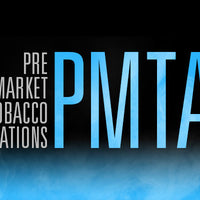In case you missed it, the FY 2021 Omnibus Appropriations Bill, also simply referred to as the appropriations or spending bill, passed by Congress in December contained an unwanted gift for the vaping industry: an amendment to the PACT Act of 2009 to include a vape mail ban.
So what exactly is the PACT Act and how exactly will the amendment affect vapers? Let us break it down for you, piece by piece – warning: you might want to grab your vape and some coffee or even an alcoholic beverage for this one 😜
No Vape Mail for You! How Congress Passed a Vape Mail Ban
On December 21, 2020, the members of Congress were given a couple of hours to study the FY 2021 Omnibus Appropriations Bill before making a vote to pass the legislation in order to avoid a government shutdown. This omnibus bill, of course, contained the much anticipated COVID-19 relief package that lawmakers had been tossing around for months. However, also buried in the 5,593-page legislation was an amendment to the PACT Act which places restrictions on mail order tobacco products.
Omni-What? Omnibus Bills Explained

Before we dig into the PACT Act, let’s talk about what an omnibus bill really is…
The latin word “omnibus” is roughly translated to mean “for all” and carries two definitions as an adjective:
- of, relating to, or providing for many things at once
- containing or including many items
The legislative process for omnibus bills is similar to standard bills: they are submitted as formal proposals containing statutes or other measures to be considered by the legislative assembly before being signed into law by the president. The difference is that an omnibus bill contains multiple pieces of legislation within a single document to be voted on all at once, rather than separately, which increases the chances of passing controversial or sometimes even “dead” legislation. Simply put, omnibus bills may provide an avenue for lawmakers to pass controversial provisions by wrapping them into packages that “everybody wants”.
Often referred to as “Big Ugly” bills, omnibus bills have been controversial since their inception due to both their large size and scope, as well as limited opportunities for debate and scrutiny. They’re also used to “veto-proof” certain pieces of legislation that may have otherwise been expected to be vetoed by the president if submitted for signature alone.
Take the latest omnibus spending bill, for example: the bill contained 5,593 pages of legislation that members of Congress had to vote on after being given just a few hours to read through and understand before making the vote. This means many most likely voted to pass measures they would have otherwise voted against had they had the time to study the bill in detail.
So What Exactly is an Omnibus Appropriations Bill?
An omnibus appropriations bill wraps smaller appropriations bills into one large, single bill to be voted on at once, rather than separately. A standard appropriations bill is legislation that Congress must pass each year to authorize funding for government spending for the fiscal year.
According to senate.gov, there are 13 different appropriations bills that Congress must pass each year to fund the federal government and avoid a government shutdown. If Congress cannot produce the separate bills in a timely fashion, they are then rolled into the omnibus appropriations bill to be voted on all at once.
So, What is the PACT Act?
Not to be confused with the PACT Act of 2019, otherwise known as the Preventing Animal Cruelty and Tortue Act, the Prevent All Cigarette Trafficking Act is an amendment passed in 2009 that requires online and other remote sellers of tobacco products to comply with the same laws that apply to local tobacco retailers under the Jenkins Act.
The PACT Act also made other revisions to the Jenkins Act, including prohibiting the use of the U.S. Postal Service to deliver tobacco products, except under narrowly-defined circumstances, and implementing package labeling and weight requirements, as well as age-verification requirements.
So, What is the Jenkin’s Act?
Passed in 1949, the Jenkin’s Act is a federal law that places restrictions on the delivery sales of cigarettes in an effort to reduce tax evasion from mail order cigarette sales. The act requires tobacco retailers, and anyone selling and shipping cigarettes, to a buyer across state lines to report the sale to the buyer’s state tobacco tax administrator on the 10th day of each calendar month, unless shipping to a licensed distributor. This report must include the names and addresses of the tobacco product recipients and the brand and quantity of the tobacco products purchased.
What’s the Purpose of the PACT Act?
Simply put, and pretty much stated in the act itself, the PACT Act is a way for state and local governments collecting sin taxes on tobacco products to ensure they get their cut. Of course, they didn’t quite put it that way, but here’s the exact language from the act:
SECTION 1. SHORT TITLE; FINDINGS; PURPOSES.(a) SHORT TITLE. — This Act may be cited as the ‘‘Prevent All Cigarette Trafficking Act of 2009’’ or ‘‘PACT Act’’.
(b) FINDINGS. — Congress finds that —
(1) the sale of illegal cigarettes and smokeless tobacco products significantly reduces Federal, State, and local government revenues, with Internet sales alone accounting for billions of dollars of lost Federal, State, and local tobacco tax revenue each year;
(2) Hezbollah, Hamas, al Qaeda, and other terrorist organizations have profited from trafficking in illegal cigarettes or counterfeit cigarette tax stamps;
(3) terrorist involvement in illicit cigarette trafficking will continue to grow because of the large profits such organizations can earn;
(4) the sale of illegal cigarettes and smokeless tobacco over the Internet, and through mail, fax, or phone orders, makes it cheaper and easier for children to obtain tobacco products;
(5) the majority of Internet and other remote sales of cigarettes and smokeless tobacco are being made without adequate precautions to protect against sales to children, without the payment of applicable taxes, and without complying with the nominal registration and reporting requirements in existing Federal law;
(6) unfair competition from illegal sales of cigarettes and smokeless tobacco is taking billions of dollars of sales away from law-abiding retailers throughout the United States;
(7) with rising State and local tobacco tax rates, the incentives for the illegal sale of cigarettes and smokeless tobacco have increased;
(8) the number of active tobacco investigations being conducted by the Bureau of Alcohol, Tobacco, Firearms, and Explosives rose to 452 in 2005;
(9) the number of Internet vendors in the United States and in foreign countries that sell cigarettes and smokeless tobacco to buyers in the United States increased from only about 40 in 2000 to more than 500 in 2005; and
(10) the intrastate sale of illegal cigarettes and smokeless tobacco over the Internet has a substantial effect on interstate commerce.
(c) PURPOSES. — It is the purpose of this Act to —
(1) require Internet and other remote sellers of cigarettes and smokeless tobacco to comply with the same laws that apply to law-abiding tobacco retailers;
(2) create strong disincentives to illegal smuggling of tobacco products;
(3) provide government enforcement officials with more effective enforcement tools to combat tobacco smuggling;
(4) make it more difficult for cigarette and smokeless tobacco traffickers to engage in and profit from their illegal activities;
(5) increase collections of Federal, State, and local excise taxes on cigarettes and smokeless tobacco; and
(6) prevent and reduce youth access to inexpensive cigarettes and smokeless tobacco through illegal Internet or contraband sales.
Notice how loss of government revenue is number one out of the ten findings listed by Congress to warrant the passing of the act, yet the bill was still passed under the guise of “protecting the children” from the “youth vaping epidemic” – an epidemic that many argue doesn’t even exist.
The Problem With the “Youth Vaping Epidemic”

The majority of youth vaping surveys done over the years have categorized youth who vaped only once in the last 30 days as regular vapers. These statistics are lumped in with the youth vaping rates to help make the case for the “youth vaping epidemic”. But, according to a recent study led by researchers at NYU School of Global Public Health, “most young people do not vape, and even fewer vape regularly.”
The study, which analyzed the 2018 National Youth Tobacco Survey in which more than 20,000 middle and high school students were asked about their use of various tobacco and vaping products in the past 30 days, found that “80 percent of youth do not use any tobacco and over 86 percent don’t vape – and among the minority who do vape, most are not regular users.”
The study also revealed that most youth who are vaping are also current or former smokers, which led to another critical finding: the sharp decline in youth smoking rates coincides with the increase in vaping rates. In other words, the majority of youth who do use electronic cigarettes are vaping for the same reason adults are: to avoid smoking tobacco cigarettes.
The implications of the study stress “the importance of including the full context use patterns” and concluded that “reporting youth vaping data with frequency and tobacco product co-use will give public health decision-makers the best possible information to protect public health”. Nonetheless, lawmakers still believe there’s a “youth vaping epidemic” and that online sales and vape mail are the problem.
Here at White Cloud, not only do we use a sophisticated age verification system to ensure our products don’t reach the hands of youth, our most recent customer survey confirmed what we’ve known for years: White Cloud products do not appeal to youth and mostly attract older adults in search of a smoking alternative. In fact, the majority of White Cloud customers are former smokers aged 55 and up.
Still, it’s no surprise that lawmakers continue to use “protecting the children” to pass their anti-vaping legislation, because of course they’re not going to admit it’s more about the money. The decline in smoking rates actually poses a bit of a financial issue for the 46 states that have been relying on tobacco revenue since the Tobacco Master Settlement of 1998.
Wait, What’s the Tobacco Master Settlement?

The Tobacco Master Settlement, also referred to as the Master Settlement Agreement (MSA) of 1998, is the largest civil litigation settlement in U.S. history, which involved 46 state attorney generals, five U.S. territories, the District of Columbia and, of course, Big Tobacco.
Under the MSA, states would receive $206 billion to be paid out by the involved tobacco manufacturers over 25 years from 2000 to 2025, with those participating manufacturers required to make annual payments based on their shares of national cigarette sales and shipments.
The funds were meant to cover the costs of smoking-related illnesses and deaths, as well as for providing funding for anti-smoking campaigns, smoking cessation programs and cancer research. Of course, the involved states haven’t exactly been living up to their end of the bargain. In fact, nearly all of them have been diverting that money into their general funding while leaving smoking cessation programs neglected and underfunded, according to a report released on the 20th anniversary of the settlement.
So, rather than allocating the funds to their intended purposes, which could have also included research into the use of electronic cigarettes for smoking cessation, states have been using the funds for anything but that. For example, North Carolina, the epicenter of tobacco production in the U.S., put 75% of its settlement funding right back into tobacco production in 2018.
With smoking rates hitting all-time lows since the rise of vaping, this could mean less funding for the states as the required payments are based on tobacco shares and sales.
So How Does the PACT Act Affect the Vaping Industry?
With the passing of the FY Omnibus Appropriations Bill in December 2020, the PACT Act of 2009 was amended to include a bill called the Preventing Online Sales of E-Cigarettes to Children Act (POSECA) which applies the “requirements relating to the delivery sales of cigarettes to the delivery sales of electronic nicotine delivery systems, and for other purposes.”
With the amendment to the PACT Act, online vape companies are prohibited from shipping vaping products via the United States Postal Service (USPS), unless the recipient is a licensed distributor. It’s also important to note that the language in POSECA states that these rules apply to “any electronic device that, through an aerosolized solution, delivers nicotine, flavor, or any other substance to the user inhaling from the device” and “any component, liquid, part, or accessory of a device…without regard to whether the component, liquid, part, or accessory is sold separately from the device.”
So what does this mean, exactly? This article from reason.com offers one of the best interpretations:
“In other words, every product related to vaping, whether of nicotine, THC, CBD, lavender, or anything else, will now be subject to the Jenkins Act’s burdensome requirements. According to Feinstein, a bottle of e-liquid is a cigarette; so is a bottle of herbal essential oil if you plan to vape it. A coil or pod cartridge for a nicotine vaporizer is now also a cigarette; so is a vaporizer designed for THC or CBD oil.”
How and Why Was the PACT Act Amended to Include Vapor Products?
Lawmakers had actually been trying to amend the PACT Act to include vapor products for quite a while. It was first introduced to the House in 2015 by Rep. Rosa DeLauro (D-CT3) as the “Stop Tobacco Sales to Youth Act of 2015” but didn’t receive a vote and died in Congress. The bill was introduced to the House by Rep. DeLauro again in 2018, but again did not receive a vote and died in Congress.
In April 2019, a similar bill, known as the Preventing Online Sales of E-Cigarettes to Children Act, was introduced to the Senate as bill number S. 1253 by Sen. Dianne Feinstein (D-CA). A few months later, it was introduced to the House, yet again, by Rep. Rosa DeLauro as bill number H.R. 3942. This time it did pass the House (on October 28, 2019), but was never passed by the Senate, while the Senate version passed the Senate (on July 2, 2020) but never passed the House.
Confused yet? Why didn’t the Senate version pass the House? Good question. The House was set to vote in July, but instead the bill was held at the desk. In legislative terms, “held at the desk” is explained as:
“A maneuver reserving the right of action on a measure to the full Chamber, rather than to a committee. A bill held at the desk is available for immediate consideration. Since it is not referred to a committee, the bill has no hearings or committee reports accompanying it from that Chamber. A bill passed by one Chamber and referred to the second Chamber often is held at the desk in the second Chamber, particularly when the second Chamber already is working on similar legislation.”
So, what about the version of the bill that passed the House but not the Senate? Another good question, but again, we can’t find a good answer. The latest action on the bill simply states it was received in the Senate.
Either way, both bills had received bipartisan support, with the House version gaining eight Republican and five Democratic cosponsors, and the Senate version gaining eight Democrats and six Republicans, so perhaps this is why they decided to roll it into the annual spending bill.
How Will the PACT Act Affect Vapers?

If you’re a vaper, you may be wondering how this will affect you personally. In a nutshell, the amendment to the PACT Act basically treats electronic cigarettes like tobacco cigarettes, despite the lack of actual tobacco. So, if you’re a former smoker, as most vapers are, then you know it’s illegal to send and receive tobacco products in the mail (except for cigars, because that makes total sense). Well, now it will also be illegal to send and receive vaping products in the mail.
This means that once the amendment to the PACT Act takes effect, you’ll no longer be able to order your vapor products online and have them mailed to your door, mailbox, or even your P.O. Box. Instead, you would be forced to choose another available carrier that offers a “ signature required upon delivery” service, which also requires additional shipping fees. This, of course, would require you to be physically present at the delivery address at the time of delivery to sign for your package – that is if other carriers offering the signature required service continue delivering vapor products.
Unfortunately, other available carriers have decided to follow suit. After hearing several rumors that UPS will no longer be shipping vaping products, the UPS website has been updated to include this statement:
“Effective April 5, 2021, UPS will prohibit the shipment of all Vaping Products throughout its domestic network including import and export and including but not limited to e-cigarette devices and e-liquids or gels, regardless of nicotine content. “Vaping Product” means any product intended for human consumption by inhalation that relies on vaporization or aerosolization, including but not limited to e-liquid, electronic cigarettes, electronic cigars, electronic cigarillos, electronic pipes, electronic vaping product delivery pens, hookah pens, and any other similar devices that rely on vaporization or aerosolization.”
And UPS is not the only carrier following suit – according to Vaping360, FedEx will also be prohibiting the shipment of vapor products as of March 1, 2021. This essentially means that vapers who rely on purchasing their products online will have to find them elsewhere, like local vape shops and convenience stores. And for those who live in rural areas, this means making the trek to a local vape shop or convenience store (and paying much higher prices), or simply going back to tobacco cigarettes since they’ll be more readily available.
When Does the PACT Act Officially Go Into Effect
The new law is set to take effect on March 27, 2021, which is the deadline for vape companies to register with the ATF and state tax administrators, while USPS has until April 26, 2021, to come up with its own regulations for enforcing the vape mail ban.





